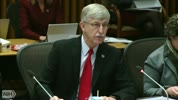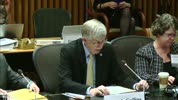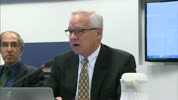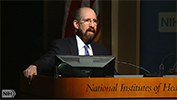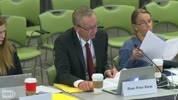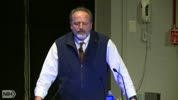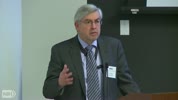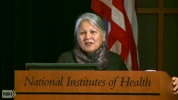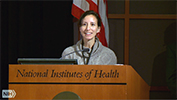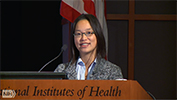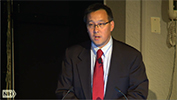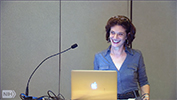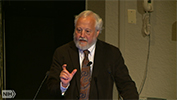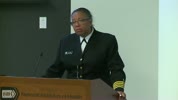-
- NIH VideoCast - Advisory Committe of the Director - December 2015 (Day 1)
-
- - Dr. Francis Collins (2015/12/15)
- - Category : Advisory Committee to the Director of the NIH
- To discuss matters with members that are important matters of work for NIH.
NIH VideoCast - Advisory Committe of the Director - December 2015 (Day 1)
-
- NIH VideoCast - Advisory Committee of the Director - December 2015 (Day 2)
-
- - Dr. Francis Collins (2015/12/15)
- - Category : Advisory Committee to the Director of the NIH
- To discuss matters with members that are important matters of work for NIH.
NIH VideoCast - Advisory Committee of the Director - December 2015 (Day 2)
-
- NIH VideoCast - Contemporary Clinical Medicine: Great Teachers: Hypertrophic Cardiomyopathy: Now a Contemporary and Treatable Disease Shaped by 50 Years of Clinical Research
-
- - Barry J. Maron, MD, Director, Hypertrophic Cardiomyopathy Center, Minneapolis Heart Institute Foundation (2015/12/12)
- - Category : Clinical Center Grand Rounds
- Contemporary Clinical Medicine: Great Teachers: Hypertrophic Cardiomyopathy: Now a Contemporary and Treatable Disease Shaped by 50 Years of Clinical Research
For more information go to http://www.cc.nih.gov/about/news/grcurrent.html
NIH VideoCast - Contemporary Clinical Medicine: Great Teachers: Hypertrophic Cardiomyopathy: Now a Contemporary and Treatable Disease Shaped by 50 Years of Clinical Research
-
- NIH VideoCast - Beyond the Lab, Understanding Communication Disorders: Preventing or Reversing Hearing Loss
-
- - Lisa Cunningham, Ph.D., Chief, NIDCD Section on Sensory Cell Biology, NIH (2015/12/12)
- - Category : Special
- Learn how research conducted by the National Institute on Deafness and Other Communication Disorders (NIDCD) is preserving hearing after exposure to life-saving drugs that can cause deafness.
Over half a million Americans experience hearing loss every year from ototoxic drugs???drugs that can damage hair cells in the inner ear. These include some antibiotics and the chemotherapy drug cisplatin. These drugs are beneficial in treating infections or cancer, but they also have the potential side effect of causing hearing loss because the drugs are toxic to hair cells in the inner ear. NIDCD intramural scientists are studying various strategies to preserve hearing without interfering with the therapeutic benefits of these drugs.
Designed for administrative and support staff as well as scientists, the Beyond the Lab, Understanding Communication Disorders speaker series gives the NIH community an opportunity to learn about the NIDCD???s research and research advances.
NIH VideoCast - Beyond the Lab, Understanding Communication Disorders: Preventing or Reversing Hearing Loss
-
- NIH VideoCast - Secretary`s Advisory Committee on Human Research Protections - December 2015 (Day 1)
-
- - HHS (2015/12/11)
- - Category : Advisory Board Meetings and Workshops
- SACHRP Meeting
SACHRP is a Federal advisory committee advising the Secretary on matters pertaining to human research protections. The agenda will focus on discussion of recommendations on the recently issued NPRM.
For more information go to http://www.hhs.gov/ohrp/sachrp/index.html
NIH VideoCast - Secretary`s Advisory Committee on Human Research Protections - December 2015 (Day 1)
-
- NIH VideoCast - Imaging Immunity
-
- - Ronald N. Germain, M.D., Ph.D., National Institute of Allergy and Infectious Diseases, NIH (2015/12/11)
- - Category : WALS - Wednesday Afternoon Lectures
- NIH Director???s Wednesday Afternoon Lecture
G. Burroughs Mider Lecture
Immune responses involve cell-cell interactions within lymphoid tissues, trafficking of activated cells to sites of effector function, and the migration of effector cells within peripheral tissues. To gain a more detailed appreciation of the relationships among cell movement, tissue architecture, stromal cell environment, and immune function, we have used intravital multiphoton microscopy and novel multiplex immunohistochemical methods we have developed called Histo-cytometry and Ce3D to analyze immune cell dynamics and tissue micro-anatomy.
The immune system has three major components involving barrier function, innate immunity, and adaptive immunity and the lecture will integrate information on all three levels to develop a comprehensive picture of how the immune system operates to provide host protection against infection. Using dynamic imaging in living animals, we have found that at sites of tissue damage such as the skin, neutrophils that are primary effectors of innate immunity are guided by stimuli from damaged barrier tissue and secondary lipid mediators to develop dense swarms that isolate the damaged area and localize infectious agents. In secondary lymphoid tissues where the adaptive immune response develops, a stromal cell network plays a key role in guiding T lymphocyte trafficking for efficient interaction of rare specific cells with FRC-attached dendritic cells presenting antigens from vaccines or infectious agents. These interactions lead to effector T cell development. After exiting the lymph nodes and then the blood to enter tissue sites, the effector T cells stop on antigen-presenting cells and make mediators that are key to host defense. An important feedback regulatory pathway titrates the effector activity of the T cells so that they do not make more mediators capable of tissue damage than is needed to control the infection.
The role of cell localization in both innate and adaptive immunity has also been addressed using Histo-cytometry that reveals at high resolution the spatial positioning and activation state of cells with complex phenotypes in tissues. With an ability to use as many as 14 different colors and antibodies not only to surface markers but to phospho-proteins and cytokines, and also to conduct imaging in large 3D volumes in an quantitative manner (Ce3D), our multiplex imaging technology is ideally suited to studies of tissue samples from animal models and human patients with respect to the phenotype, number, location, signaling state, and function of immune cells and stromal elements in tissue sites including cancer. Using these static imaging tools, we have discovered the role of dendritic cell positioning in controlling responses to infections and vaccines as well as the localized environment in which regulatory T cells control potential autoimmune responses in normal individuals.
Using these specific examples, this lecture will illustrate the power of in situ imaging for the acquisition of a more accurate picture of the molecular, cellular, spatial, and temporal aspects of cell function and signaling events involved in immune responses
About the G. Burroughs Mider Lecture:
Established in 1968 in honor of the first NIH director of laboratories and clinics, the lecture, part of the Wednesday Afternoon Lecture Series and an NIH intramural scientist???s outstanding contributions to biomedical research.
For more information go to https://oir.nih.gov/wals
NIH VideoCast - Imaging Immunity
-
- NIH VideoCast - NIH Recombinant DNA Advisory Committee - December 2015
-
- - OSP NIH (2015/12/10)
- - Category : Recombinant DNA Advisory Committee
- 144th meeting of the NIH Recombinant DNA Advisory Committee.
NIH VideoCast - NIH Recombinant DNA Advisory Committee - December 2015
-
- NIH VideoCast - Three Decades of Neuroscience, Glutamate Receptor Channels
-
- - NIH (2015/12/10)
- - Category : Conferences
Three Decades of Neuroscience on Glutamate Receptor Channels
- 9:30 a.m. Welcome and Opening Remarks
- 9:35 a.m. "Who knew NMDA Receptors did this....." Gary Westbrook, M.D., Senior Scientist and Co-Director, Vollum Institute, Oregon Health and Science University
- 10:05 a.m. ???Too many Potassium Channels???Bruce Bean, Ph.D., Robert Winthrop Professor of Neurobiology, Department of Neurobiology, Harvard Medical School
- 10:35 a.m. ???Glutamate Receptor Pores???James Huettner, Ph.D., Professor, Department of Cell Biology and Physiology, Washington University in St. Louis
- 11:05 a.m. Break
- 11:30 a.m. ???NMDA Receptors: Presynaptic, Postsynaptic, Metabotropic????Craig Jahr, Ph.D., Senior Scientist, Vollum Institute, Oregon Health and Science University
- 12:00 p.m. ???The Functional Anatomy of the Ionotropic Glutamate Receptor Family???Derek Bowie, Ph.D., Professor, McGill University
- 12:30 p.m. ???AMPA Receptor Domains and Synaptic Trafficking???Roger Nicoll, M.D., Professor, University of California, San Francisco
- 1:00 p.m. Lunch
- 2:00 p.m. ???Structure of ASIC1-Snake Toxin Complex Reveals Mechanism of Ion Selectivity in ENaC/DEG Channels???Isabelle Baconguis, Ph.D., Vollum Fellow, Vollum Institute, Oregon Health and Science University
- 2:30 p.m. "Glutamate Receptors: Lights, Camera, Action"Andrew J R Plested, Ph.D., Group Leader, Molecular Neuroscience and Biophysics, Leibniz-Institut Fur Molekulare Pharmakologie
- 3:00 p.m. ???G Protein Activation of the GIRK Potassium Channel???Roderick MacKinnon, M.D., Professor, Laboratory of Molecular Neurobiology and Biophysics, Rockefeller University
- 3:30 p.m. Break
- 4:00 p.m. ???Structure, Function, and Biology of NMDA Receptors???Hiro Furukawa, Ph.D., Associate Professor, Cold Spring Harbor Laboratory
- 4:30 p.m. "Molecules, Mechanisms and Mark: Adventures in Atomic Exploration at Chemical Synapses"Eric Gouaux, Ph.D., Senior Scientist, Vollum Institute Oregon Health and Science University
- 5:00 p.m. ???What`s in a name? AMPA and Kainate Receptors in Flies and Ctenophores???Mark Mayer, Ph.D., Senior Investigator, Laboratory of Cellular and Molecular Neurophysiology, Eunice Kennedy Shriver National Institute of Child Health and Human Development, National Institutes of Health
- 5:30 p.m. Closing RemarksStory C. Landis, Ph.D., Scientist Emeritus, NINDS Intramural Program
NIH VideoCast - Three Decades of Neuroscience, Glutamate Receptor Channels
-
- NIH VideoCast - Common Fund High-Risk, High-Reward Research Symposium (Day 2)
-
- - NIH (2015/12/10)
- - Category : Conferences
- The NIH Common Fund is pleased to present the 2015 High-Risk, High-Reward Research Symposium. The Symposium will bring together recipients of the Pioneer, New Innovator, Transformative Research, and Early Independence Awards to share groundbreaking research and discoveries.
For more information go to https://commonfund.nih.gov/highrisk/symposia15
NIH VideoCast - Common Fund High-Risk, High-Reward Research Symposium (Day 2)
-
- NIH VideoCast - Introduction to the Principles and Practice of Clinical Research (IPPCR) 2015: Secondary Data/Meta-Analysis
-
- - Charles Natanson, M.D., NIH (2015/12/10)
- - Category : IPPCR
- The Introduction to the Principles and Practice of Clinical Research (IPPCR) is a course to train participants on how to effectively conduct clinical research. The course focuses on the spectrum of clinical research and the research process by highlighting epidemiologic methods, study design, protocol preparation, patient monitoring, quality assurance, and Food and Drug Administration (FDA) issues.
For more information go to http://clinicalcenter.nih.gov/training/training/ippcr1.html
NIH VideoCast - Introduction to the Principles and Practice of Clinical Research (IPPCR) 2015: Secondary Data/Meta-Analysis
-
- NIH VideoCast - Interagency Pain Research Coordinating Committee - December 2015
-
- - NIH (2015/12/09)
- - Category : Advisory Board Meetings and Workshops
- The Interagency Pain Research Coordinating Committee (IPRCC) is a Federal advisory committee created by the Department of Health and Human Services to enhance pain research efforts and promote collaboration across the government, with the ultimate goals of advancing the fundamental understanding of pain and improving pain-related treatment strategies.
For more information go to http://iprcc.nih.gov
NIH VideoCast - Interagency Pain Research Coordinating Committee - December 2015
-
- NIH VideoCast - Tribal Ecological Knowledge Workshop (Day 1)
-
- - National Institute of Environmental Health Sciences, NIH (2015/12/09)
- - Category : Conferences
- The Tribal Ecological Knowledge (TEK) workshop will explore the contributions that Native American (NA) and Alaskan Native (AN) tribal communities bring to the research enterprise. This workshop will focus on the value of TEK for environmental health sciences (EHS) and biomedical research. The term TEK denotes "traditional knowledge [that], like Western science, is based on accumulation of observation. It is knowledge that is transmitted through generations, practice in how tribes carry out resource use practices, and beliefs about how people fit into ecosystems" (Berkes, 2000). The term is widely used by tribal communities to denote a range of factors affecting Native health from an indigenous perspective. We propose that TEK is a culturally appropriate form of community-engaged research that could benefit biomedical research focused on environmental factors affecting health, and may also be a way to increase trust and mutual respect in tribal-academic partnership. In addition, we believe that TEK is an example of citizen science, which we would like to highlight due to the increased attention to citizen science as a viable element of research among researchers and federal agencies. The workshop goals are to explore ways to improve trust in academic-tribal research; to identify methods for incorporating community-acquired data and local TEK into environmental health and biomedical research studies; to consider ethical approaches for tribal specific data collection; and to build capacity to respond to long term and immediate disaster events. This workshop has been organized by representatives of seven tribal communities working with NIH (NIEHS and NIMHD), Indian Health Service, Smithsonian Museums, and CDC/ATSDR staff. We believe that hosting a workshop around the theme of TEK will raise awareness of the importance of this type of contribution to research and garner input from those with expertise in TEK to identify the optimal ways to incorporate it into research.
For more information go to http://tools.niehs.nih.gov/conference/tek_workshop_2015/index.cfm
NIH VideoCast - Tribal Ecological Knowledge Workshop (Day 1)
-
- NIH VideoCast - Tribal Ecological Knowledge Workshop (Day 2)
-
- - National Institute of Environmental Health Sciences, NIH (2015/12/09)
- - Category : Conferences
- The Tribal Ecological Knowledge (TEK) workshop will explore the contributions that Native American (NA) and Alaskan Native (AN) tribal communities bring to the research enterprise. This workshop will focus on the value of TEK for environmental health sciences (EHS) and biomedical research. The term TEK denotes "traditional knowledge [that], like Western science, is based on accumulation of observation. It is knowledge that is transmitted through generations, practice in how tribes carry out resource use practices, and beliefs about how people fit into ecosystems" (Berkes, 2000). The term is widely used by tribal communities to denote a range of factors affecting Native health from an indigenous perspective. We propose that TEK is a culturally appropriate form of community-engaged research that could benefit biomedical research focused on environmental factors affecting health, and may also be a way to increase trust and mutual respect in tribal-academic partnership. In addition, we believe that TEK is an example of citizen science, which we would like to highlight due to the increased attention to citizen science as a viable element of research among researchers and federal agencies.
The workshop goals are to explore ways to improve trust in academic-tribal research; to identify methods for incorporating community-acquired data and local TEK into environmental health and biomedical research studies; to consider ethical approaches for tribal specific data collection; and to build capacity to respond to long term and immediate disaster events.
This workshop has been organized by representatives of seven tribal communities working with NIH (NIEHS and NIMHD), Indian Health Service, Smithsonian Museums, and CDC/ATSDR staff. We believe that hosting a workshop around the theme of TEK will raise awareness of the importance of this type of contribution to research and garner input from those with expertise in TEK to identify the optimal ways to incorporate it into research.
For more information go to http://tools.niehs.nih.gov/conference/tek_workshop_2015/index.cfm
NIH VideoCast - Tribal Ecological Knowledge Workshop (Day 2)
-
- NIH VideoCast - Common Fund High-Risk, High-Reward Research Symposium (Day 1)
-
- - NIH (2015/12/09)
- - Category : Conferences
- The NIH Common Fund is pleased to present the 2015 High-Risk, High-Reward Research Symposium. The Symposium will bring together recipients of the Pioneer, New Innovator, Transformative Research, and Early Independence Awards to share groundbreaking research and discoveries.
For more information go to https://commonfund.nih.gov/highrisk/symposia15
NIH VideoCast - Common Fund High-Risk, High-Reward Research Symposium (Day 1)
-
- NIH VideoCast - Introduction to the Principles and Practice of Clinical Research (IPPCR): Using Large Datasets for Population-Based Health Research
-
- - Leighton Chan, M.D., NIH (2015/12/09)
- - Category : IPPCR
- The Introduction to the Principles and Practice of Clinical Research (IPPCR) is a course to train participants on how to effectively conduct clinical research. The course focuses on the spectrum of clinical research and the research process by highlighting epidemiologic methods, study design, protocol preparation, patient monitoring, quality assurance, and Food and Drug Administration (FDA) issues.
For more information go to https://ippcr.nihtraining.com/login.php
NIH VideoCast - Introduction to the Principles and Practice of Clinical Research (IPPCR): Using Large Datasets for Population-Based Health Research
-
- NIH VideoCast - Principles of Clinical Pharmacology ~ Pharmacogenomics
-
- - Shiew-Mei Huang, Ph.D., FDA (2015/12/08)
- - Category : Principles of Clinical Pharmacology
- The "Principles of Clinical Pharmacology" course is a weekly lecture series covering the fundamentals of clinical pharmacology as a translational scientific discipline focused on rational drug development and utilization in therapeutics. The course is offered annually at the NIH Clinical Center and runs from September through April.
NIH VideoCast - Principles of Clinical Pharmacology ~ Pharmacogenomics
-
- NIH VideoCast - Good Behavior: Sharing, and Reusing Research Video
-
- - Karen E. Adolph, PhD, New York University (2015/12/08)
- - Category : BSSR - Behavioral and Social Sciences
- NIH Behavioral and Social Sciences Seminar Series
Behavior is infinitely rich. In natural and laboratory settings, children exhibit an extraordinary array of behaviors???visual exploration, facial expressions, speech, gestures, locomotion, and social interactions. Video captures much of this richness and complexity. Using a broad range of examples, I show how video makes the fleeting, ephemeral nature of behavior tangible and permanent, and how researchers can use video to find the extraordinary in the most ordinary behaviors and, conversely, to reveal hidden structure in the most extraordinary behaviors. Indeed, video is so rich that it can be reused to ask new questions beyond the scope of the original study. In this sense, all behavior is good behavior???valuable to other researchers and capable of yielding new insights into the causes and consequences of learning and development. Data reuse exploits the richness of video to increase scientific transparency, accelerate the pace of discovery, and facilitate understanding of the causes of health and disease. These ideas motivate the Databrary project (databrary.org), funded by NIH and NSF, which enables video sharing and reuse among developmental researchers. With Databrary, the contribution of a particular dataset will no longer depend on the private activities of one researcher, but will instead benefit from the imagination of many researchers with different viewpoints.
Learn more and REGISTER http://events.r20.constantcontact.com/register/event?oeidk=a07ebit2msr88a3a768&llr=vykrlptab
AUTHOR: Karen E. Adolph, Ph.D., New York University
For more information go to https://obssr.od.nih.gov/news_and_events/lectures_and_seminars/BSSR_lecture_series/seminars.aspx
NIH VideoCast - Good Behavior: Sharing, and Reusing Research Video
-
- NIH VideoCast - Ethics Rounds: Is It Ethical to Conduct Research on Previous Obtained Cell Lines Without Donors` Consent
-
- - Eric Juengst, PhD, Professor, Department of Genetics and Director, Center for Bioethics, University of North Carolina, Chapel Hill and Eugene Kane, MPH, Public Health Advisor, Office of Clinical Research, NIMH, NIH (2015/12/04)
- - Category : Clinical Center Grand Rounds
- Ethics Rounds: Is It Ethical to Conduct Research on Previous Obtained Cell Lines Without Donors` Consent
For more information go to http://www.cc.nih.gov/about/news/grcurrent.html
NIH VideoCast - Ethics Rounds: Is It Ethical to Conduct Research on Previous Obtained Cell Lines Without Donors` Consent
-
- NIH VideoCast - The NIH Academy Roundtable 3 -- Health Disparities in Aging Populalations Part 1
-
- - Michele K. Evans, MD; Deputy Scientific Director, NIA, NIH (2015/12/04)
- - Category : Career Development/OITE
- The NIH Academy provides trainees with an overview of the scientific, social, economic, cultural, environmental, and policy factors that contribute to health disparities. This lecture focuses on health disparities in aging minority populations.
For more information go to https://www.training.nih.gov
NIH VideoCast - The NIH Academy Roundtable 3 -- Health Disparities in Aging Populalations Part 1
-
- NIH VideoCast - Somatic Hypermutation by Error-prone DNA Polymerases
-
- - Patricia J. Gearhart, Ph.D.; Senior Investigator, Laboratory of Molecular Biology and Immunology, NIA, NIH (2015/12/04)
- - Category : Immunology
- Immunology Interest Group
Patricia Gearhart started her independent career at the Carnegie Institution of Washington and progressed to the Johns Hopkins University where she was one of the pre-eminent faculty of the Immunology Graduate Program. In 1996 she joined the NIH and moved to the National Institute on Aging, Baltimore Bayview campus. Her laboratory has focused on antibody diversity. Beginning with understanding how the B-cell repertoire is shaped, her work evolved towards understanding the mechanisms of antibody refinement in the germinal center: somatic hypermutation and class switch recombination. Her lab???s specific focus is to understand the mechanisms that direct activation-induced deaminase (AID) and various specialized DNA polymerases to the immunoglobulin loci to initiate the storm of mutations and DNA breaks that create antibody diversity. A fundamental understanding of these processes is critical to understanding the adaptive immune response, and the diseases that arise when these processes are dis-regulated. Pat always has great science to share. She is a broad and innovative thinker and excellent speaker. Even if B cells are not your ???thing???, Don???t miss this talk.
NIH VideoCast - Somatic Hypermutation by Error-prone DNA Polymerases



